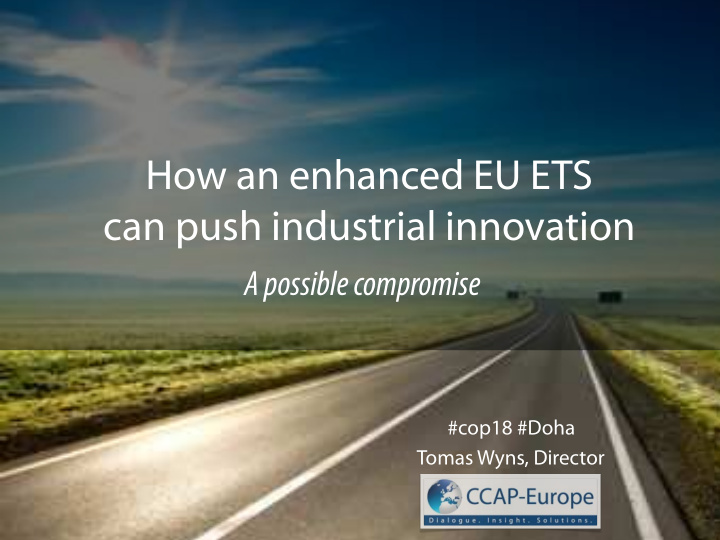



How an enhanced EU ETS can push industrial innovation A possible compromise #cop18 #Doha Tomas Wyns, Director
European Commission’ s 2050 low-carbon roadmap 110 100 90 Reference Scenario 80 70 -40% 60 50 40 30 Reduction Scenario -80% 20 10 0 1990 1995 2000 2005 2010 2015 2020 2025 2030 2035 2040 2045 2050 Reductions Investments Savings -80 to -95% by 2050 € 270 Bn p.a. € 170-320 Bn p.a. Fuel cost in EU economy: -80% = domestic, ref. 1990 jobs € 88 Bn in 2050 infrastructure R&D Air quality and health EU Member States agree on targets but not on interim milestones
2050 projections for Industry 100% 100% 80% 75% 66% 56% 60% D e N p 50% l e o w y m T e e c n h t n o o f l o g y 25% 17% Low-end Industrial sectors scenario E.C. 2050 low-carbon roadmap High-end scenario 13% 0.8% pa e ffi ciency improvement as from 2005 ( fi xed production) 0% 1990 2005 2030 2050
2050: The challenge for EU industry 100% 75% !! 10-15 years time left Deployment of New to develop & 60% Technology 50% make breakthrough technologies market ready 25% 13% 0% 1990 2005 2030 2050
Reduction Potential in some industrial sectors Deep reductions are possible In cement, steel, paper and chemical sectors (over time) Steel Cement 120 120 Reference level (average EU cement kiln) Reference level (average EU blast furnace) 100 100 New blast furnace Relative CO 2 emission Relative CO 2 emission Fastmelt 80 80 New Cement kiln (using biomass) 60 60 Top gas recycling with CCS Fastmelt with CCS 40 40 HIsarna with CCS 20 20 Oxy-fuel technology with CCS Electrolysis (using renewable electricity) Magnesium Oxide Cement 0 0 2005 2010 2015 2020 2025 2030 2005 2010 2015 2020 2025 2030 Year the mentioned technologies likely become operational on commercial scale Year the mentioned technologies likely become operational on commercial scale
Will the EU ETS bring about these breakthroughs? • EU ETS is valuable carbon pricing instruments (cost-effective reductions driven by opportunity cost) • but EU ETS will not bring about break-through technologies (e.g. ULCOS type). Costs and risks are too high. • Complementary policy/support required • There is a precedent (NER300) but that was “mainly” aimed at the energy sector
Enhancing the EU ETS for innovation: a policy compromise • immediate intervention in ETS through set-aside/delayed auctioning of EU allowances followed by • permanent scarcity through changing ETS caps as soon as possible (but only auctioning part) • recycle part of delayed auctioning into EU industrial low carbon innovation fund [similar to NER 300 approach] • Free allowances remain untouched up to 2020 • Carbon leakage list frozen until 2020
The policy compromise Permanent cap reduction Set Aside auctioning auctioning Delayed (remainder) auctioning total cap in “The revenues from the delayed auction go to new EU fund for industrial 2013-2020 modernisation. The goal of this fund is to bring low-carbon product and process breakthroughs to the market by 2025-2030. This type of industrial policy has the goal to ensure both the survival Free Free and the sustainability of Europe’s manufacturing industry”
EU ETS compromise concept: an example (!) Auctioned later and recycled to 600 1,200 industrial Innovation fund Cancelled at later date 600 set aside 7,500 (e.g. phase IV) Permanent cap adjustment through linear auctioning 300 correction factor from 1.74% to 2.5% as from (million 2015 continuing beyond 2020 allowances) ≈ assuming 50/50 split 6,000 between free Results in and auctioned auctioning 15,000 allowances (remainder) 900 million total cap in 2013-2020 less allowances in 2013-2020 (million allowances) 10-24 EUR/t average carbon price Free Free in 2013-2020 10 Bn EUR Support for industrial modernisation
Suggestions for industrial innovation policy/funding Spire SILC II Process Innovation Bio-based i ppp ULCOS II Horizon 2020 R&D into higher value added products 10 Bn EUR Product Products contributing to (2015-2020) EU low carbon roadmap Innovation Diversification into new products, services and/or production/supply chains Social Social transition, Education & Entrepreneurship Innovation
“The wall, the writing” 1.1 Trillion EUR by 2020 (*) Chinese public/private investments in 7 strategic emerging 130 Bn EUR industries: part of EU MFF 2014-2020 Horizon 2020: 80 Bn Energy Saving & Environmental protection EU CEF: 50 Bn Next gen IT best case scenario Biotech High end equipment manufacturing New Energy systems New Materials New Energy vehicles (*) http ://mobile.reuters.com/article/idUSTRE7AK0MT20111121?irpc=932
“Innovation distinguishes between a leader and a follower” Steve Jobs Thank You Tomas Wyns twyns@ccap.org
Recommend
More recommend